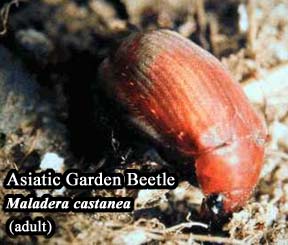Canna (Canna)
Plant
Health Problems
Diseases caused by Bacteria:
Bacterial leaf spot, Xanthomonas.
Infections usually start at the leaf margins and can spread along
the veins into the center of the leaf. Spots are brown and
irregular and often appear as discrete spots with yellow halos.
This disease can be minimized by improving air circulation by
thinning the plants and by avoiding overhead irrigation. Picking
and destroying infected leaves is also helpful. Chemical control
is not usually necessary.
Insect Problems:
 Asiatic garden beetle,
Maladera castanea.
Asiatic garden beetle,
Maladera castanea.
The grubs of this imported insect also feed on grass roots and
are responsible for considerable injury to lawns. The life
history is similar to that of the Japanese beetle, but adults fly
more and are attracted to lights. Adults feed at night on many
kinds of plants, especially aster, barberry, bean, cherry,
chrysanthemum, currant, dahlia, geranium, catalpa, seedling
conifers, rhododendrons and strawberries. During the day, the
beetles, which hide in the soil around the plants, are seldom
seen unless one knows where to find them. The beetle is about
3/4" long, velvety cinnamon brown with a faint iridescence.
Treating nearby lawns with insecticides described under Japanese
beetle usually gives effective control. Asiatic garden beetle
appears to be the least susceptible of the four common exotic
scarabs to imidacloprid, and is not controlled with halofenozide,
but can be controlled with trichlorfon.
Canna leaf rollers, Calpodes ethlius and
Geshna cannalis.
These insects may occur in the northern states but are killed by
severe winter weather. The larvae of the large canna leaf roller
cuts a section out of the margin of the leaf and rolls it over
and lives within while it feeds. Later holes are eaten in the
leaf. The larva is green with an orange head and transforms to a
brownish butterfly. The lesser canna leaf roller has similar
habits in addition to tying the young leaves together before they
open.
Among the compounds registered for control of this pest in Connecticut is malathion which can be applied several times during the season. Consult the label for dosage rates and safety precautions.
Celery leaftier, Udea rubigalis.
Although this small greenish-white striped caterpillar may
occasionally feed on leaves, it is not a serious pest and control
is rarely needed.
Japanese beetle, Popillia japonica.
This beetle, in the adult stage, feeds upon a great variety of
trees and plants, including canna. The beetle is ½" long,
bright, shining green, with copper colored wing covers. Two white
spots on the tip of the abdomen show beyond the ends of the wing
covers, and there are five white spots formed by patches of white
hairs on each side of the abdomen. The beetles begin emerging in
late June but their greatest abundance is usually about the
middle of July. During drought periods populations of Japanese
beetle are drastically reduced.
Japanese beetle traps containing floral and sex attractant lures are readily available at home and garden centers. These traps may help reduce the overall number of beetles. However, beetles often land and feed on plants close to traps, so traps should be placed well away from valued plantings. Feeding on canna foliage can be prevented by using sprays of acephate, azadirachtin, carbaryl or malathion, which are among the products registered for use against this pest in Connecticut. Imidacloprid, applied early in the season as a soil drench, will provide season-long systemic control. Consult the labels for dosage rates and safety precautions. Larvae develop in turf, so treatment of lawn areas should reduce the numbers of beetles.

